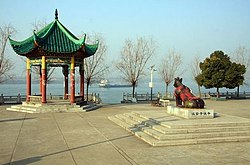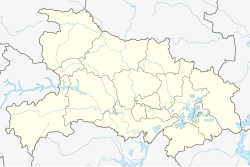Jiangling County
Jiangling County
江陵县 Kiangling | |
|---|---|
 Jiangling Tieniuji | |
| Coordinates: 30°08′N 112°30′E / 30.133°N 112.500°E | |
| Country | People's Republic of China |
| Province | Hubei |
| Prefecture-level city | Jingzhou |
| Population (2020)[1] | |
• Total | 468,276 |
| Website | www |
Jiangling (Chinese: 江陵; pinyin: Jiānglíng; Wade–Giles: Chiang-ling) is a county in southern Hubei province, People's Republic of China. Administratively, it is under the jurisdiction of Jingzhou City.
History
[edit]The county name derived from the old name of Jingzhou. Liang Dynasty Prince Xiao Yi (蕭繹; 507–555) was made governor of Jingzhou, of which Jiangling was the provincial capital, at about the time that scholar and writer Yan Zhitui (531–590s) was born there. After defeating the Hou Jing Rebellion, Xiao Yi took the Liang throne, but instead of moving back to the imperial capital at Jiankang (Nanjing), he settled in Jiangling -- although his courtiers had advised otherwise. In 553, he allied with the Western Wei regime to attack his own younger brother, Xiao Ji (蕭紀; 508–553), who had used his own position as governor in Sichuan to declare himself emperor. Unfortunately for the Liang Dynasty as a whole, this enabled Western Wei to take the Shu area (Sichuan) and then turn against Xiao Yi, attacking Jiangling in 554 and conquering the city with great brutality. [2]
In 1994, Jiangling County was dissolved and converted to two districts (Jingzhou and Jiangling) of Jingzhou City. The current Jiangling County was established in 1998, when the Jiangling District, then covering 11 outlying towns and townships, was again reverted to county status.[3]
Administrative divisions
[edit]Two townships:
Three other areas:
References
[edit]- ^ "China: Húbĕi (Prefectures, Cities, Districts and Counties) - Population Statistics, Charts and Map". www.citypopulation.de. Retrieved 2024-11-22.
- ^ Tian Xiaofei and Paul Kroll, Family Instructions for the Yan Clan and Other Works by Yan Zhitui (531–590s) (Berlin, Boston: De Gruyter Mouton, 2021. https://doi.org/10.1515/9781501503191, pp. xv-xvii.
- ^ "历史沿革 (Timeline of Jingzhou)". Jingzhou City Government. Archived from the original on 4 March 2017. Retrieved 16 November 2019.
- ^ 江陵县历史沿革 [Jiangling County Historical Development]. 行政区划网站 www.xzqh.org (in Chinese). 行政区划网站/区划地名网站 (Administrative Divisions Web/District Geographic Names Web). 6 August 2014. Retrieved 13 July 2018.
2010年第六次人口普查,江陵县常住总人口331344人,其中:资市镇22261人,滩桥镇21788人,熊河镇38689人,白马寺镇41470人,沙岗镇40336人,普济镇31729人,郝穴镇44100人,马家寨乡35400人,秦市乡23067人,江北监狱11369人,三湖管理区12457人,六合垸管理区8678人。
- ^ 2016年统计用区划代码和城乡划分代码:江陵县 [2016 Statistical Area Numbers and Rural-Urban Area Numbers: Jiangling County]. National Bureau of Statistics of the People's Republic of China. 2016. Retrieved 13 July 2018.
统计用区划代码 名称 421024100000 资市镇 421024102000 熊河镇 421024103000 白马寺镇 421024104000 沙岗镇 421024105000 普济镇 421024106000 郝穴镇 421024200000 马家寨乡 421024201000 秦市乡 421024450000 江北监狱 421024500000 三湖管理区 421024501000 六合垸管理区
- ^ 行政区划 [Administrative Divisions]. 江陵县人民政府网站 (in Chinese). 江陵县人民政府办公室 江陵县电子政务管理办公室 江陵县政务公开管理办公室. Archived from the original on 13 July 2018. Retrieved 13 July 2018.
以原江陵县资市、滩桥、熊河、白马寺、沙岗、普济、郝穴7镇和马家寨、秦市2乡以及江北监狱、三湖农场、六合垸农场所辖国土面积为江陵区版图范围。
External links
[edit]

